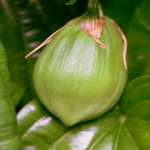| Common Name: |
Stemona |
| Botanical Name: |
Stemona tuberosa syn. Roxburghia gloriosa |
| Genus: |
Stemona |
| Family: |
Stemonaceae |
| Native Location: |
India, China, Indochina and N mainland Malaysia. |
| Cultivation: |
Light, well-drained soil in sun or partial shade. Cut back in early spring to restrict growth. |
| Propagation: |
By seed sown in autumn; by semi-ripe cuttings in spring; by division when dormant. |
| Harvest: |
Tubers are lifted during dormancy, scalded in boiling water, and sun-dried for decoctions. |
| Height: |
5-10m (15-30ft) |
| Hardiness: |
Min. 15-18°C (59-64°F) |
| Parts Used: |
Tubers (bai bu) |
| Properties: |
A bitter-sweet, cooling herb that lubricates the lungs, controls coughing, destroys parasites, and is anti-bacterial and anti-fungal. |
| Medicinal Uses: |
Internally for bronchitis, dry cough, tuberculosis, whooping cough, amebic dysentery, and pinworms. Baked with honey for coughs. Externally for lice, fleas, and ringworm. Used fresh to make insecticidal washes and sprays. |
| Bibliography: |
Encyclopedia of Herbs by Deni Brown Copyright © 1995, 2001 Dorling Kindersley Limited Pg 375 |

